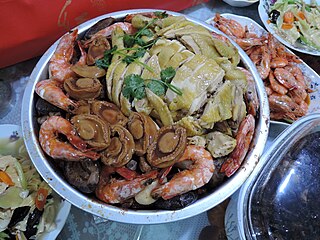 W
WAn agape feast or lovefeast is a communal meal shared among Christians. The name comes from agape, a Greek term for 'love' in its broadest sense. The plural agapae or agapæ has been used by itself in reference to lovefeasts, but is ambiguous, as it can also mean funerary gatherings.
 W
WBeshbarmak is the national dish among nomadic Turkic peoples in Central Asia and Russia. It is also known as naryn in Xinjiang, Uzbekistan, Kyrgyzstan and Kazakhstan, as turama or dograma in Karakalpakstan, North Caucasus and Turkmenistan, and as kullama in Bashkortostan and Tatarstan.
 W
WCustoms and etiquette in Chinese dining are the traditional behaviors observed while eating in Greater China. Traditional Han customs have spread throughout East Asia to varying degrees, with some regions sharing a few aspects of formal dining, which has ranged from guest seating to paying the bill.
 W
WThe clambake or clam bake, also known as the New England clambake, is a traditional method of cooking seafood, such as lobster, mussels, crabs, soft-shell clams, and quahogs. The food is traditionally cooked by steaming the ingredients over layers of seaweed. The shellfish can be supplemented with vegetables, such as onions, carrots, and corn on the cob. Clambakes are usually held on festive occasions along the coast of New England.
 W
WA communal meal is a meal eaten by a group of people that serves a social and/or ceremonial purpose.
 W
WFondue is a Swiss melted cheese dish served in a communal pot over a portable stove (réchaud) heated with a candle or spirit lamp, and eaten by dipping bread into the cheese using long-stemmed forks. It was promoted as a Swiss national dish by the Swiss Cheese Union in the 1930s, and was popularized in North America in the 1960s.
 W
WHot pot or hotpot, also known as soup-food or steamboat, is a cooking method that originates from Mongolia, prepared with a simmering pot of soup stock at the dining table, containing a variety of East Asian foodstuffs and ingredients.
 W
WKabsa is a mixed rice dish, served on a communal platter, that originates from Saudi Arabia but is commonly regarded as a national dish in countries of the Arabian peninsula.
 W
WKamameshi (釜飯) literally translates to "kettle rice" and is a traditional Japanese rice dish cooked in an iron pot called a kama. Kamameshi originally referred to rice that was eaten communally from the kama. Coworkers or family members either ate directly from the kama pot or by transferring the rice to individual bowls. The term emerged in the late Meiji period, and is associated with the communal eating of rice in the aftermath of the 1923 Great Kantō earthquake. Later, similar to takikomi gohan, kamameshi came to refer to a type of Japanese pilaf cooked with various types of meat, seafood, and vegetables, and flavored with soy sauce, sake, or mirin. By cooking the rice and various ingredients in an iron pot, the rice gets slightly burned at the bottom which adds a desirable flavor to the rice. Kama designed specifically to prepare kamameshi appeared on the market as the dish became popular across Japan, and the prepared kamameshi is placed directly on the table in its pot for the meal. A small-scale replica of the kama is used to create an individual serving of kamameshi, and the dish is now a popular ekiben.
 W
WPoon choi or puhn choi, pén cài in pinyin, is a traditional Cantonese festival meal composed of many layers of different ingredients. It is served in large wooden, porcelain or metal basins called poon, due to the communal style of consumption. The Chinese name, transliterated as Poon choi, has been variously translated as "big bowl feast", "basin cuisine" or "Chinese casserole".
 W
WA potluck is a communal gathering where each guest or group contributes a different, often homemade, dish of food to be shared.